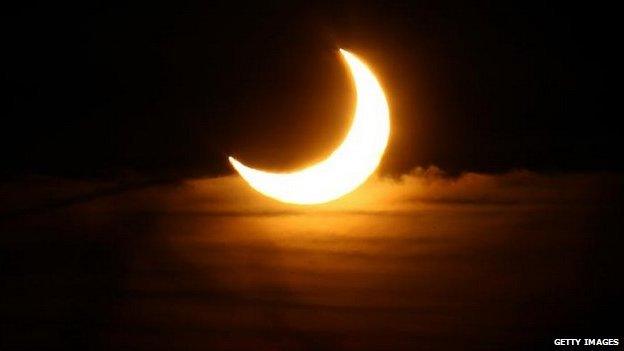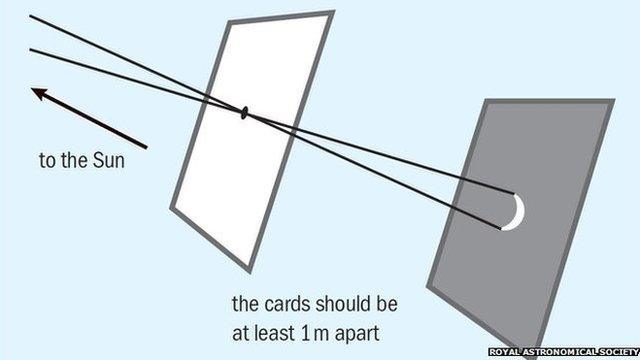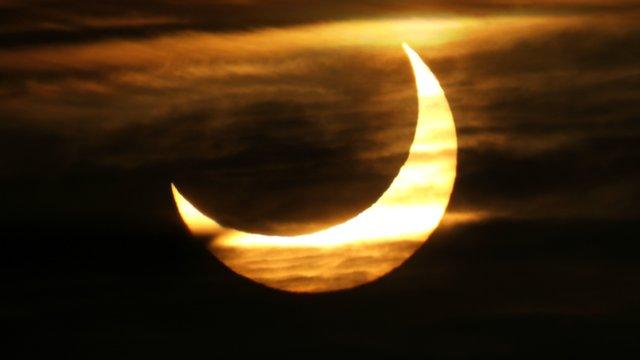High chance of seeing a solar eclipse
- Published

The solar eclipse is due to begin at about 08:30 on Friday
It will be the greatest show off Earth - if the weather is kind.
Children on their way to school will stop and look upwards to watch. There are also concerns the spectacle could halt rush-hour traffic.
And as Professor Martin Hendry, of Glasgow University's School of Physics and Astronomy says, that is hardly new.
"Thousands of years ago people were fascinated by eclipses because they thought there was some terrible fate about to befall the sun," he said.
"Chinese culture had it that there was a dragon trying to swallow the sun and of course they would all bang gongs to make it go away.
"And it always worked...because the sun would come back again."
The principle behind a solar eclipse is simple enough: the Sun shines on the Earth but occasionally the Moon gets in the way. It casts a moving shadow on the surface of the planet.
Dark shadow
Where the Moon completely obscures the disc of the Sun, that is a total eclipse. Night makes a brief return.
On Friday that tight, dark shadow will fall on the northern Atlantic, passing over the Faroe Islands and the Arctic archipelago of Svalbard.
A much wider shadow will surround it. People on either side of the path will notice morning reverting to twilight.

The Sun's disc will not be obscured completely but large areas of Europe, North Africa and Asia should get a good view of a partial eclipse.
Scotland is particularly well situated. At least 90% of the face of the Sun will be obscured wherever you are. The further north and west you go, the greater the eclipse will be.
In Glasgow, almost 94% of the Sun's disc will be blocked by the Moon.
In Portree, Kirkwall and Lerwick more than 96%. And in the far west of Lewis just over 98%. The merest sliver of the Sun will remain.
The dragon will start to nibble the Sun at about 08:30.
The eclipse will be at its greatest just over an hour later. And - gong-bashing or not - the Moon will have passed on its way not long after 10:40.
Dos and don'ts
If you're thinking of taking a squint at the eclipse the best advice is: do not.

A solar eclipse should only be viewed using protective glasses
Even with 98% of the Sun blacked out, the remaining 2% is enough to blind you. Screwing up your eyes will not help. Looking through binoculars or a telescope will only make it worse.
Only dedicated solar filters and viewers are safe. Home-made "solutions", such as looking through sunglasses, clouds or exposed photographic film will not protect you.
One counterintuitive method is to look the other way. Take two pieces of card and punch a small hole in one of them.
It need not be a pinprick - up to four or five millimetres across will still work.
Tilt the card with the hole towards the Sun and use it to project an image of the eclipse onto the other card.
Congratulations, you have just made a pinhole camera (the more egotistical among us may even like to make a series of holes spelling out our name. Then you should be able to see your name, if not in lights, then in a series of tiny eclipses).
Solar eclipses are reassuringly predictable. The next big partial eclipse in these parts will be in August 2026.
What is altogether less predictable - now and then - is Scottish weather.
Aircraft images
At the time of writing, the forecast is less than promising for most parts of the country. Many of us may be left hoping for a break in the clouds, or at least for the rain to stop.
The internet means that when someone gets lucky we all get to share.

Pinhole cameras should only be used with your back to the Sun
Images are likely to appear from vessels in mid-Atlantic, from aircraft above the clouds, and from the blacked-out Faroes and Svalbard.
Beyond our atmosphere, the European Space Agency's Proba-2 satellite is ready to send pictures.
And if all else fails, we may be able to listen to the eclipse. Radio enthusiasts are being asked to tune their sets to medium wave frequencies in the hope that stations, normally only received at night, may be heard during daytime because of the effect of the Moon's shadow on the ionosphere.
Should you be thwarted by the weather, think of the lengths some people are prepared to go to to ensure a clear view of an eclipse.
One intrepid group went far into the Sahara desert. No clouds, big sky.
It would have been perfect if a sandstorm had not blown up.
- Published17 March 2015

- Published14 March 2015

- Published12 March 2015
